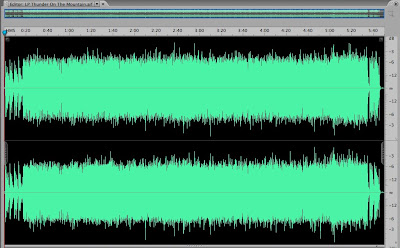… or at least his little helper. You know, the little guy who sneaks in when Mr Frost has gone for lunch, and turns knobs that are best left alone. His intentions may be the noblest, but as we all know, Satan sometimes comes as a Man of Peace.
Frost, who also goes by the name of Bob Dylan, has produced a number of said artist’s records, and one would suspect that he, of all people, would agree with Dylan’s harsh verdict in a recent Rolling Stone interview on the sound quality of records today:
You listen to these modern records, they’re atrocious, they have sound all over them. There’s no definition of nothing, no vocal, no nothing, just like — static.
A fairly recent blogpost by Sean Curnyn takes up this statement and turns it back on Dylan. Curnyn refers to a series of posts by Pete Bilderback on his blog Flowering Toilet, which give graphical examples of the difference in dynamic range between LP and CD versions of the same songs.
Here’s the LP version of ‘Thunder on the Mountain’:

And here is what most of us — who are not sound geeks and have therefore bought the CD — hear:

The difference (according to the two posts — I’m no expert in sound engineering), stems from the abuse of compression, a technique that is used in order to fill the sound-space as much as possible, and make the music stand out more clearly, even in the soft moments. Put to moderate use, it can enhance a recording, but as a weapon in the “Loudness War”, it is lethal — it kills the dynamic range in the recording (as the above examples show), and since dynamics is one of the most important tools to make music alive, we may have a serious baby and bath water situation here.
I refer to the other posts for further evidence and explanation. I, for one, am convinced, and it’s ironic that the “static” that Dylan refers to is so predominant on his own latest albums.
Why there should be this difference between the CD and the LP versions, I don’t know. One of the commenters at the Flowering Toilet mentions that the same difference could be noticed between the version of ‘Beyond Here Lies Nothing’ which was given out as a free download, and the version on the released album. So apparently the little helper works late, and only in the CD plant.
For the record, if I consider Modern Times and especially Together Through Life lacklustre and on the whole unsucessful, it’s mainly because of the material. But a sound (huh…) advice for Dylan/Frost might be: Don’t shoot yourself in the foot — shoot the sound engineer instead.
Thanks to Heinrich Küttler of SEAL fame for bringing those posts to my attention.